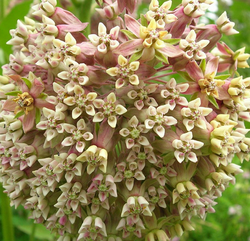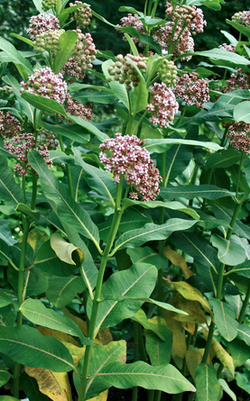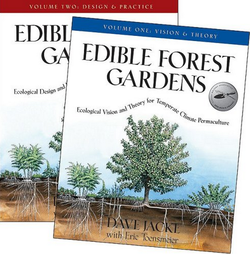 Asclepias syriaca, Milkweed Asclepias syriaca, Milkweed We can think of at least 180 great forest garden & perennial crops for cold climate Sweden. Want to hear about them? Over the course of the next year we will profile 5 a week on the blog. Perennial plants and crops offer a low energy, oil & resource input based foundation for future-proof agricultures. By default if an agriculture is to be called regenerative the bottom line is that it must be soil building, not soil depleting. Relentless deep tillage & poor soil husbandry (wifery?!) contributes to the majority of the 24 billion tons of topsoil lost every year on planet water. We are going to be focused on holistic polyculture grazing and perennial production at ridgedale over most of the site as this represents the most effective way to restore our degraded landscape, produce high value produce and ensure the future resource base we are managing holistically for in our decision making.  Genus Asclepias Species syriaca Common Name milkweed Form herb Habit running Origin North America Light sun Moisture mesic Edible greens, shoots, pods, flowers Asclepias syriaca- commonly called common milkweed, butterfly flower & silkweed, is a species of flowering plant. This species is native to Southern Canada and of much of the conterminous Eastern U.S, east of the Rocky Mountains, excluding the drier parts of the Prairies. Common milkweed is a perennial herb growing up to 2.6 m tall from a rhizome. The all parts of common milkweed plants produce white latex when broken. The leaves are opposite or sometimes whorled; simple, broad ovate-lanceolate; up to 25 cm long and 12 cm broad, usually with undulate margins and reddish main veins. They have very short petioles and velvety undersides. Although no specific reports have been seen for this species, many, if not all, members of this genus contain toxic resinoids, alkaloids and cardiac glycosides. They are usually avoided by grazing animals. The older leaves are poisonous if eaten in large quantities. The plant contains cardioactive compounds and is potentially toxic. Unopened flower buds can be cooked. They taste somewhat like peas. They are used like broccoli. Flowers and young flower buds can also be cooked. They have a mucilaginous texture and a pleasant flavour, they can be used as a flavouring and a thickener in soups, etc. The flower clusters can be boiled down to make a sugary syrup. The flowers are harvested in the early morning with the dew still on them. When boiled up they make a brown sugar. Young shoots can be cooked and eaten as an asparagus substitute. They should be used when less than 20cm tall. Tips of older shoots are cooked like spinach. Young seed pods, 3 - 4 cm long can also be cooked. They are very appetizing. If picked at the right time, the pods resemble okra. The root is anodyne, diaphoretic, diuretic, emetic, expectorant and purgative. It has been used in the treatment of asthma, kidney stones, venereal disease, etc. Caution is advised, see the notes above on toxicity. An infusion of the pounded roots has been used by the women of some native North American Indian tribes to promote temporary sterility. The leaves and/or the latex are used in folk remedies for treating cancer and tumours. The milky latex from the stems and leaves is used in the treatment of warts. The latex needs to be applied at least daily over a period of up to a few weeks to be effective. The stems can be cooked and applied as a poultice on rheumatic joints. One reported Mohawk antifertility concoction contained milkweed and jack-in-the-pulpit, both considered contraceptive. Dried and pulverized, a fistful of milkweed and three Arisaema rhizomes were infused in a pint of water for 20 minutes. The infusion was drunk, a cupful an hour, to induce temporary sterility. The rhizome is used in homeopathy as an antioedemic and emmenagogue in the treatment of dropsy and dysmenorrhoea. The seed floss is used to stuff pillows etc or is mixed with other fibres to make cloth. It is a Kapok substitute, used in Life Jackets or as a stuffing material. Very water repellent, it can yield up to 550 kilos per hectare. The floss absorbs oil whilst repelling water and so has also been used to mop up oil spills at sea. Candlewicks can be made from the seed floss. OUR FRIENDS AT PFAF HAVE AN AMAZING DATABASE OF SPECIES (UK BASED);Last day TO SIGN UP TO OUR NEWSLETTER IF YOU WANT TO BE IN TO WIN A FREE COPY OF THE AWESOME EDIBLE FOREST GARDEN MANUALs... Sign up to our newsletter for articles/ updates you choose & fortnightly awesome book giveaways... We're going to celebrate 2014 by giving away a copy of Edible Forest Gardens 1 & 2 to thank our subscribers. These books are epic to say the least, make sure you sign up to our customizable newsletter for details... Seasons greetings!
0 Comments
Leave a Reply. |
Details
Like us on FB Below for regular updatesStay up to date with customized updates you want to receive
Upcoming coursesArchives
December 2016
Categories
All
|

 RSS Feed
RSS Feed